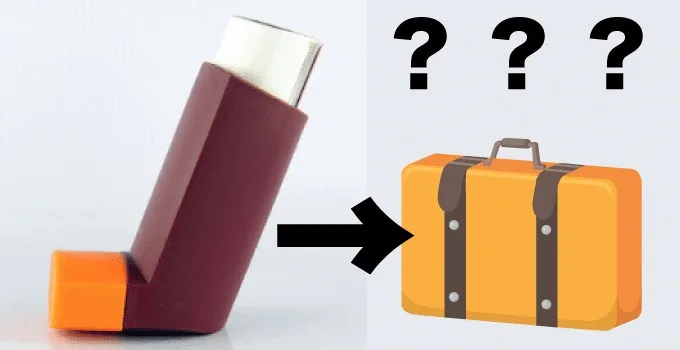Are asthma inhalers allowed in hand luggage?
The answer is yes! You are allowed to bring asthma inhalers (both metered-dose inhalers [MDI] and dry powder inhalers [DPI]) in your hand luggage. If your inhaler contains liquid (aerosol-based type = MDI), then you should make sure to transport it in the bag of liquids. However, the general 100 ml rule for liquids in hand luggage does not apply to this latter type of asthma inhalers either, as there is an exception for liquid medicine in hand luggage that applies in this case.
Do you need a prescription/doctor’s note for your asthma inhaler?
In most of the cases, you will pass the airport security check with your asthma inhaler even if you do not have a prescription or doctor’s note with you. This especially holds true for medical equipment that is within the range of of the liquids rule (in the US: Liquids 3-1-1 rule).
The truth is that many official sources will tell you that you will need supporting documentation from a relevant medical professional for your inhaler. But in most of the cases, you won’t actually need to provide these documents at the airport security (or anywhere else).
If your inhaler does indeed contain more than 100 ml of liquid, you should bring supporting documentation because in this case, the exemption for medical equipment in hand luggage applies but only if you can provide these documents (a letter from your doctor or a copy of your prescription).
Moreover, a prescription letter or a doctor’s note might facilitate the security process, as the staff can see at a glance what kind of medicine they are dealing with. So to play it safe, you should bring these documents.
Furthermore, it is always a good idea to transport medicines and medical devices in their original packaging whenever possible to avoid delays at the security checkpoint.
Does my inhaler count as a liquid at the security check?
There are dry-powder inhalers (contain no liquid) and there are metered-dose inhalers (MDI), which release a fixed dose of medication in aerosol form.
The latter are indeed counted as liquids at the airport security. However, this won’t be a problem because most inhalers only contain a very small amount of liquid (less than 100 ml, so they do not violate the liquids 3-1-1 rule/rules for liquids in hand luggage).
Moreover, even if they would contain more than 100 ml it would still not be a problem because medically necessary liquids are allowed in larger quantities and are, therefore, exempt from the liquids rule (you might need to provide a prescription letter/doctor’s note in this case, though).
What’s more, you will need to store this kind of aerosol-based inhaler (MDI) in the bag of liquids, just as any other liquid that you bring in your carry-on bag.
What about asthma inhalers in carry-ons in the US?
In the US, asthma inhalers are allowed both in carry-on luggage as well as in checked baggage.
Please make sure to remove your inhaler from your carry-on bag at the security checkpoint, as it will need to undergo X-ray screening.
Medically necessary liquids, gels, and aerosols (such as the liquid in your inhaler) are exempt from the liquids 3-1-1 rule. So you don’t need to worry about the capacity of your inhaler (even if more than 100 ml, it won’t be a problem).
The TSA, the American Transportation Security Administration, does further recommend that you label your medication to facilitate the security process.
Air travel with asthma
The filtered air in the aircraft cabin can be very dry. This can cause people living with asthma to have difficulty breathing. For this reason, you should always carry your emergency medication with you in your hand luggage. In general, it is always advisable to bring all types of medicine in your hand baggage instead of stowing it in your checked baggage.
Checked baggage often gets lost or arrives late at its destination. If you are then at the destination airport without your essential medication, this can, of course, have serious consequences.
Important information: We are no doctors here at carry-on-baggage.com. Reading this article can of course not replace a medical consultation. Asthmatics should always contact their trusted doctor to discuss the exact procedure and all eventualities.
Related Questions
Can hairspray be carried in hand luggage?
Yes, but the rule for liquids in hand luggage must be observed and the hairspray needs to be non-flammable (check symbol on the hairspray). You must, therefore, place the hairspray in the bag of liquids and it must be a travel-size hairspray, as only 100 ml per container is permitted. You can find such hairsprays at Amazon, for example.
Are nebulisers allowed in hand luggage?
Yes, absolutely. Mainly, the same rules apply to nebulisers as to asthma inhalers when carried in your hand luggage. This is the case for both EU and US travel.
Are you allowed to use a nebuliser on a plane?
In principle, some airlines allow the use of a nebuliser on board. As a rule, this must be a portable, battery-operated nebuliser. Since not every airline has the same rules here, you should contact the airline in advance and ask again whether use onboard is permitted or not.
How much liquid do inhalers contain?
Most relievers only contain a small amount of liquid, namely between 10 to 20 ml and are, therefore, well within the 100 ml allowance.
Can I put an inhaler in checked luggage?
You can also place your inhaler in checked baggage. There are no restrictions concerning flight safety. However, transport in hand luggage is generally to be preferred, as crucial medical equipment should always be within easy reach. You might want to put a spare in your checked luggage, though.
Does my inhaler have any chance of blowing up when I take an airplane?
The likelihood of your inhaler exploding on board is extremely small. First of all, the cabin is pressurised and, secondly, every day, thousands of passengers take their asthma inhalers into the cabin of the plane without negative consequences.

Hey guys! It’s me, Marcel. I am the proud owner of carry-on-baggage.com. I am dealing with hand luggage related issues on a daily basis and I own several websites in this niche. Travelling is one of my biggest passions in life and I, therefore, happen to know a thing or two about hand luggage. I hope you all have a safe trip! Take care and thanks for the support. I really appreciate it.
